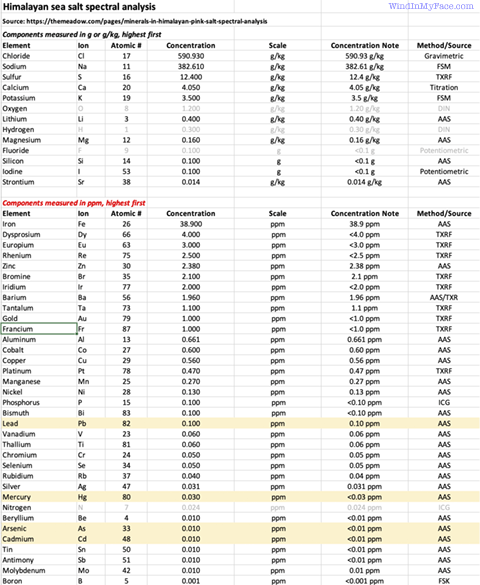Certificate of Analysis (COA): Himalayan Pink Sea Salt
re: heavy metals
re: potassium
re: certificate of analysis
Thorsten K writes:
Thank you so much for the write-up on COA and Nutricost Magnesium Chloride! Very helpful! I’ve used the same brands of MgCl you mentioned, and I did not know about the heavy metal analysis of these, or Nutricost.
One question: You mentioned Himalayan Sea Salt. Did you find one with a similar type of analysis? I’m also using that, but there are so many brands, and I’ve been wondering what is really in it…
WIND: I did some sleuthing to see what minerals and toxins are present in Himalayan sea salt. Is it better for you by virtue of trace minerals? How does it fare for heavy metals?
Background: wikipedia: Himalayan salt
Himalayan salt is rock salt (halite) mined from the Punjab region of Pakistan. The salt, which often has a pinkish tint due to trace minerals, is primarily used as a food additive to replace refined table salt but is also used for cooking and food presentation, decorative lamps and spa treatments. The product is often promoted with unsupported claims that it has health benefits.
...Himalayan salt lacks these beneficial effects of iodine supplementation...
Due mainly to marketing costs, pink Himalayan salt is up to 20 times more expensive than table salt or sea salt. The impurities giving it its distinctive pink hue, as well as its unprocessed state and lack of anti-caking agents, have given rise to the unsupported belief that it is healthier than common table salt. There is no scientific basis for such claimed health benefits. In the United States, the Food and Drug Administration warned a manufacturer of dietary supplements, including one consisting of Himalayan salt, to discontinue marketing the products using unproven claims of health benefits.
...
WIND: the alternative seems to be sea salt. But given widespread industrial contamination of the entire world, I’ll take the eons-old rock salt any day, barring a certificate of analysis proving that sea salt is free of modern contaminants and heavy metals*.
Studies have found some microplastic contamination in sea salt from the US, Europe and China.[18] Sea salt has also been shown to be contaminated by fungi that can cause food spoilage as well as some that may be mycotoxigenic
Further searching suggests that lacking a certificate of analysis for any particular salt, you are just guessing. Various internet sites pushing their own product are lack credibility—accept no generalizations, demand a COA if a vendor claims better quality.
* Industrial contamination (heavy metals, microplastics, nasty chemicals of all sorts) spans the earth from pole to pole. As an egregious example, the snowmelt off Mt Everest is unfit for human consumption due to toxic heavy metals from coal-burning China.
Minerals in Himalayan Pink Salt: Spectral Analysis
The heavy metals content of this Himalayan sea salt varies by the deposit, so this is just one example, from an unspecified mine.
This analysis that gives a nice breakdown; I have converted the data to spreadsheet form. It was posted by a Himalayan salt vendor and I don’t know who the data source is.
The benefits and harms are very unclear about having oddball elements like strontium, bromine, barium, bismuth tantalum, gold, francium, etc and rare elements like dysprosium. Nor am I sure about whether the trace mineral content is nutritionally meaningful (maybe not). OTOH, if humans evolved in sea water long ago, a mix of elements similar to that makes sense at some fundamental level.
Expressed in ppm, consuming one gram = 1000mg of this salt equates those ppm figures into micrograms (mcg).
These are low levels of lead (Pb), Cadmium (Cd), Arsenic (Ar), mercury (Hg). Consuming such salt should not be a concern; you’d have to eat a whopping 10 grams (10000mg) of salt to get 1 mcg of lead. Moreover, it is very possible that alternative sources of salt might have higher levels of heavy metals.
See also Chemical evaluation of Major salt deposits of Pakistan further below, which appears to confirm these figures.
| Himalayan Sea Salt | ppm = mcg | Micrograms (mcg) per gram (1000mg) of salt |
|---|---|---|
| Lead (Pb) | 0.10 | 0.10 |
| Mercury (Hg) | < 0.03 | 0.03 |
| Arsenic (Ar) | < 0.01 | 0.01 |
| Cadmium (Cd) | < 0.01 | 0.01 |

Chemical evaluation of Major salt deposits of Pakistan
2006. See the scanned PDF. This article exists only in scanned (picture) form.
The metal load in all of the samples are within safe limits, so there is no serious concern about heavy metals...
 Spectral analysis for elements in Himalayan Pink Salt
Spectral analysis for elements in Himalayan Pink SaltThe impurities in the Kohat and Khallar salt must be removed prior to safe human consumption while Khewra salt may be used as such for food purposes. Due to the highest quality of lake salt and white crystal salt Khewra, these may be used by pharmaceutical companies after treating it with pyrogen removing techniques...
WIND: the figures for lead (Pb) and cadmium (Cd) correspond to the other analysis above, at least for Pinkish Salt. As Himalayan pink salt (Khewra) has 1/3 to 1/2 the lead of the other varieties, it is the best choice for daily consumption.
See also: An overview of Pakistan rock salt resources and their chemical characterisation








